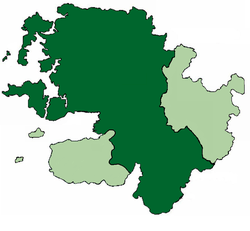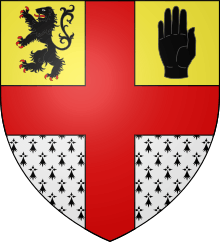Mac William Íochtar
Mac William Íochtar (Lower Mac William), also known as the Mayo Burkes, were a fully Gaelicised branch of the Hiberno-Norman House of Burke in Ireland. The territory covered much of the northern part of the province of Connacht. The Mac William Íochtar functioned as a regional king and received the White Rod. The title was a successor office to the Lord of Connacht which ended upon the assassination of William Donn de Burgh, 3rd Earl of Ulster, in June 1333.
Lower Mac William Mac William Íochtar | |||||||||||
|---|---|---|---|---|---|---|---|---|---|---|---|
| c. 1330–1602 | |||||||||||
 County Mayo, c. 1590 Mac William Íochtar territory (dark green) Vassals of Mac William Íochtar (light green) | |||||||||||
| Capital | Kilmaine (inauguration site) | ||||||||||
| Common languages | Irish | ||||||||||
| Religion | Roman Catholicism | ||||||||||
| Government | Tanistry | ||||||||||
| Chief | |||||||||||
• 1332–1375 | Edmond Albanach de Burgh | ||||||||||
• 1595–1602 | Tibbot MacWalter Kittagh Bourke | ||||||||||
| History | |||||||||||
• Established | c. 1330 | ||||||||||
• Disestablished | 1602 | ||||||||||
| ISO 3166 code | IE | ||||||||||
| |||||||||||
History
As a result of the Burke Civil War of the 1330s, the Lordship of Connacht was split between two opposing factions of the de Burgh family: the Burkes of Mac William Uachtar (or Clanricarde) in southern Connacht and the Mac William Íochtar Burkes of northern Connacht. For over three hundred years, the two families dominated the politics of the province, frequently fighting each other for supreme rule of both the Anglo-Irish and Gaelic-Irish peoples.
List of Mac William Íochtar
- Edmond Albanach de Burgh, 1332–1334 (died November 1375)
- Thomas mac Edmond Albanach de Burca, 1375–1402
- Walter mac Thomas de Burca, 1402 – 7 September 1440
- Edmund na Féasóige de Burca, 1440–1458
- Tomás Óg de Burca, 1458–1460
- Risdeárd de Burca, 1460–1469 (died 1473)
- Ricard Ó Cuairsge Bourke, 1469–1473
- Theobald Bourke, 1479 – 5 March 1503
- Ricard Bourke, 1503 – 7 July 1509
- Edmond de Burca, 1509 – 23 February 1514
- Meiler Bourke, 1514 – 28 April 1520
- Edmond de Burca, 1520 – 29 September 1527
- Seaán an Tearmainn Bourke, 1527–?
- Theobald mac Uilleag Bourke, ?–1537
- David de Burca, 1537–?
- Ricard mac Seaán an Tearmainn Bourke, ?–1571
- Seaán mac Oliver Bourke, 1571–1580
- Richard the Iron Bourke, 1580–1582
- Richard Bourke, 1582–1586
- William "the Blind Abbot" Bourke, 1586–1593 (Abolition)
- Tibbot MacWalter Kittagh Bourke, December 1595 (Restoration) – March 1601
- Richard "the Devils Hook" Bourke, March 1601 – October 1601
- Tibbot MacWalter Kittagh Bourke, October 1601 – January 1602 (Abolition)
In 1594 Tibbot ne Long Bourke, one of the most prominent men in the country, accepted terms of surrender and regrant. In 1627 he was created Viscount Mayo.[1]
See also
References
- Chambers A., Shadow Lord: Theobald Bourke, Tibbott-Ne-Long, 1567–1629: Son of the pirate queen Grace O'Malley (Ashfield Press, Dublin 2007) pp65-66.
- Hubert T. Knox (1908), The history of the county of Mayo to the close of the sixteenth century, p. 395
- Lower Mac William and Viscounts of Mayo, 1332-1649, in A New History of Ireland IX, pp. 235–36, Oxford, 1984 (reprinted 2002).
